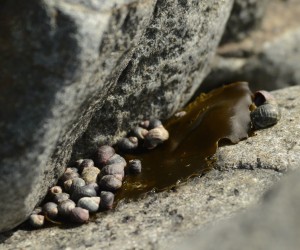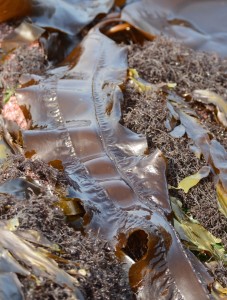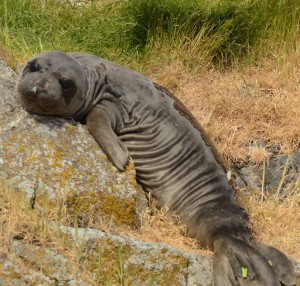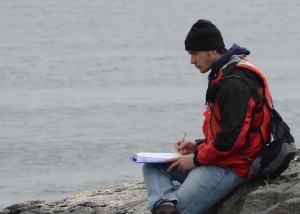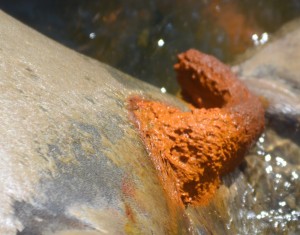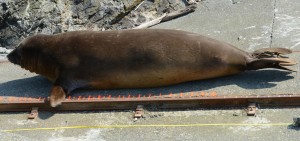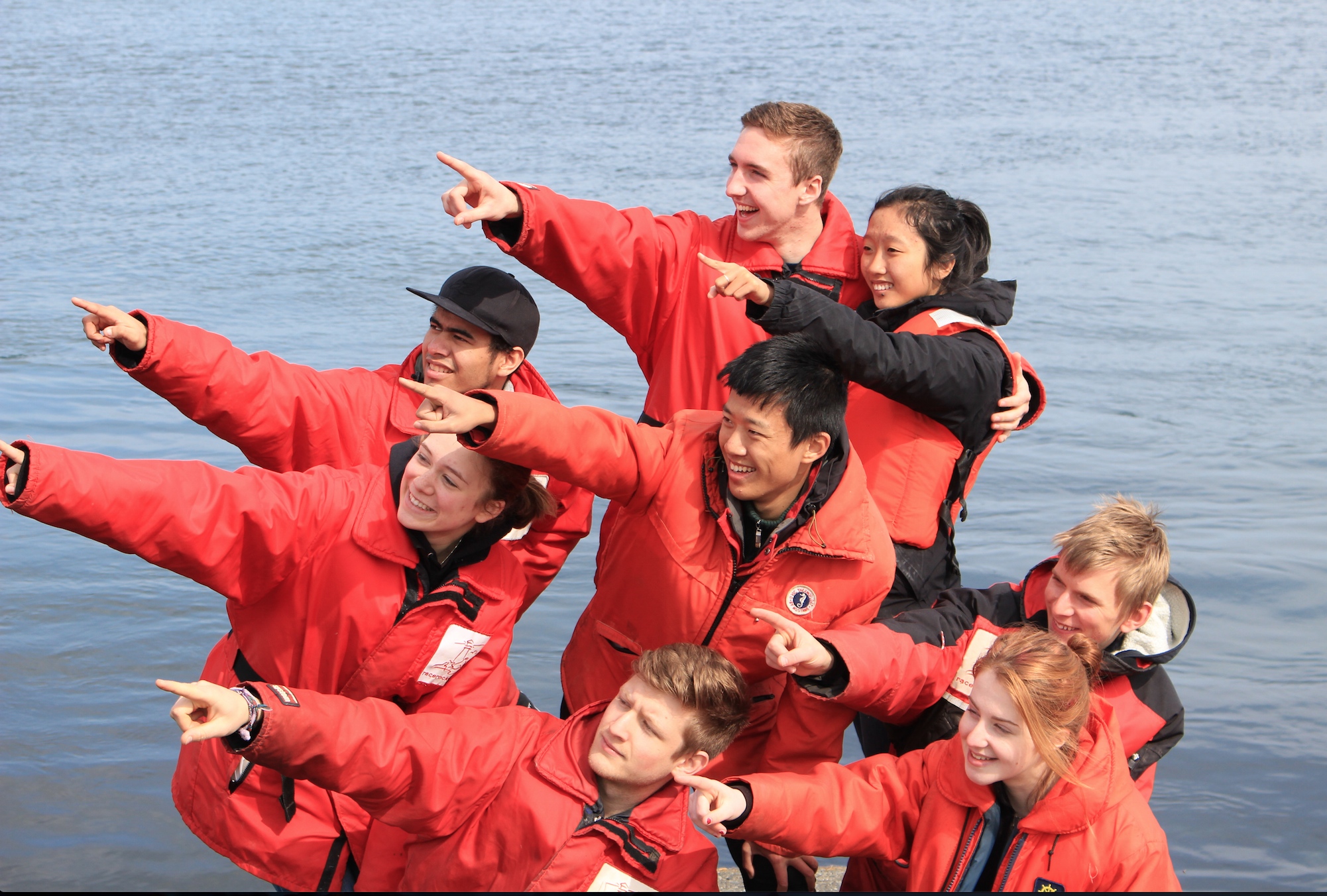Weather: southwesterly wind 15 knots, calm sea, good visibility, atmospheric pressure :1024(HPA).Guy changed the membrane of the desalinator and now it’s working well. He changed the anemometer and speedometer. The gulls now are not so aggressive anymore and it was an easy job. He put on the electric fence around the main house and jetty. Catherine and Noemi cleaned the outside seawater sampling shed with brushes and a big flow of saltwater pumped directly from sea. A lot of fun! At the end of the afternoon we went and count the seashore birds, cormorants, oystercatchers and guillemots for the weekly animal census. We counted from the tower the gulls, sea lions and harbor seals.
Category Archives: PC Students at Race Rocks
2 new residents on the rocks
Weather: 21 knots early rising 25 knots in the afternoon – Air temperature: 12 degrees Celsius -Water 12 degrees too. Barometric pressure: 1014 (HPA).
Birds: I saw a blue heron attacked by gulls so he left for the south Island and a fly of 20 cormorants. A big bloody chicken was under the diesel tank. This made a total of 9 dead found chickens.
Noemi and Catherine arrived for their 15 days of summer services. They came with Courtney and Chris. We went around and help them to settle in their new house. Courtney checked with Guy the desalinator and the testing they did showed that the membrane needed to be changed. After that they looked at the connections for the electrical fence and decided the spots needed protection from the sea lion’s invasion, especially around the 2 houses and the crane. The old ladder went ashore and will be replaced by a new stainless steel one.
Overcast and gale warning forecast
They even spoke about some rain! It would have been a chance to get some rock cleaning done. I even didn’t think about the grass which was green long time ago, yellow a few days ago and brownish now with the lying sea lions. The generator and the desalinator were working in anticipation of the students: Noemi and Catherine who will be with us from tomorrow to the 27th .We did a check up in their house and cleaned the windows of the 2 houses. We found 2 more bodies of some very small chicks on the rocks: fight for territory between 2 gulls families I guess.
Patches of Fog.
The fog was hanging like a wall to the west when we left the island early this morning and on return this evening, the fog was just wrapping around the island. Winds stayed west-southwest and were gusting over 30 knots this evening. The barometer started dropping after noon, holding steady at ~1013 hPa., up to that point. At sunset it was down to 1008 hPa. Cumulative solar energy was ~ 550 Langleys today, down from yesterday, so I am guessing there was some fog here during part of the day, as yesterday it was up at 600 Ly. The forecast for tomorrow is for more of the same, westerly winds, a strong wind warning and fog patches. The fog “patch” is a big one extending up the west coast to at least Bamfield.
On yesterday’s intertidal foray, there were numerous large Hemigrapsus nudus shore crabs in a fairly high tidal pool with only one rock. This is not the ‘usual’ habitat where I am used to finding this species: but perhaps because of the high current they shelter in high tidal pools instead of under cobbles and boulders, a little lower in the intertidal. It is also possible that some may be another species as some of them have a very rounded instead of rectangular carapace.
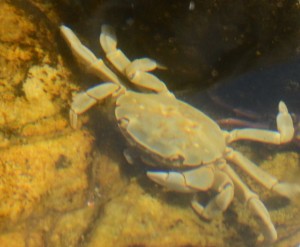
This crab and the one in the next photo have rounded carapaces with definite notches as opposed to the more rectangular carapace of the common shore crabs. Will report back on identification confirmation.
Another example of gigantism here is exhibited in the Littorina spp. or periwinkles. They are much larger than I am used to seeing and every little piece of kelp blown into the high intertidal is immediately (at a snail’s pace) consumed.
The elusive Kildeer that normally arrive after dark and leave before light, came early tonight in the fog. Observations of two individuals revealed interesting interactions. One individual fanned out (her?) tail feathers held high, with head down and wings out and down, while the other individual did some serious head bobbing.
It is not known what vessels were or were not in reserve today
The student advisee group and their adults (and small child) left mid-morning today. Don arrived for a few days.
Chores were routine today.
Great Tide at Great Race.
Fog in the morning, fog in the evening, sunshine in the afternoon: this is the weather pattern right now. Strong westerly winds from 20 to 33 knots blow all day and all night. It is really all about equilibrium with that huge mass of cold Pacific water and cool air temperatures rushing in to cool a rapidly warming ‘interior’. Yesterday afternoon there was a ten-degree air temperature difference between here (in fog and wind) and the Victoria airport (in brilliant sunshine). Off in the far distance to the east, thunderheads are visibly forming as that warm air rises and takes moisture with it.
Today, as yesterday, the barometer climbed until about noon and then fell by about the same amount, ending up at ~ 1014 hPa., in the late afternoon. The forecast is for continued strong wind warnings and patches of fog.
There were no vessels observed in the Ecological Reserve today.
Excellent daytime low tides continue and a few more species of algae have been added to my list. Pleurophycus gardneri, the broad-ribbed kelp was growing at 0.2m as was Saccharina groenlandica, the split kelp, which used to be known as a Laminaria. A couple of reds included Endocladia muricata, an important species used as settling substrate for California Mussels and a branching coralline species in a tidal pool, possibly Corallina vancouverensis (jury still out on that id).
On the elephant seal front, the small, tagged male 9807, decided to climb up a very steep hill and he had quite a time getting back down. Rock climbing is just not an strong point for elephant seals. It probably seemed like a good idea to go up in order to get away from the boisterous larger males but coming down a different and much more difficult route, he looked a little worried and wane, with his big eyes and his baggy skin.
Ten students, two teachers and a small child came out for an advisee group retreat overnight and they are well ensconced in the science house.
Chores and maintenance were routine today.
Finally Field Exam.
It blew west 15 – 20 knots all day as the barometer slowly climbed to 1016 hPa and leveled off. The early, overcast sky gave way to sunshine by late morning and it continued brilliantly until sunset. The forecast is for more of the same with the strong wind warning continuing.
Two whale watching boats were observed working in the Ecological Reserve and both followed guidelines and regulations, treating the Reserve and its wildlife with respect. Several sports fishing boats passed through the Ecological Reserve at low speed and only one halibut sports fishing boat was slow to slow, in the go-slow zone, doing at least 15 knots but eventually remembering and slowing.
All of the ecological happenings reported on, in the last week or so continued today. Great Race was busy with Northern Elephant seals coming and going from their bathing routines, moulting, sleeping and jousting. The gulls, guillemots and oystercatchers continued to prepare for the next generation and Canada Geese were out and about, promenading their goslings. A raven was seen taking one small gosling that had been noted dead earlier, near a nest in front of the science house. Both species of sealion seem more vocal this week, with the Steller’s mostly on West Rocks and the Californians more spread out but definitely back at South Islands.
Today was busy with visitors as Laura and 36 first year marine science students arrived early to do their marine science field exam. Chris and Courtney, shuttled the class out in Second Nature and Hyaku. An extra trip in Hyaku brought out author Peter Johnson who is researching lighthouses for an up-coming book, along witha guest photographer. Hanne, a second year marine science student from Pearson College also arrived on that trip and she photographed the first years hard at work and enjoyed observing elephant seals with Courtney.
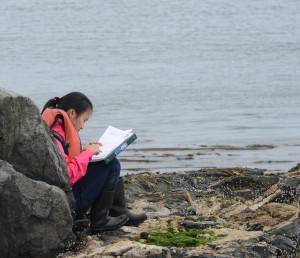
Ha finishes off answers on biodiversity and species richness, surrounded by diverse intertidal species.
My family continued their visit and helped out in lots of different ways, from assisting boats and people on the jetty, to encouraging me in becoming more proficient and comfortable running the derrick. I assisted Laura and students with the field exam, which is very unique. This is one exam the students will never forget.
Population Explosion
During the early morning there were light winds from the north but it soon switched to west and blew 25 to 30 knots mid-morning. The wind dropped down to a lazy 5 to 10 from the west and swung through south to east and back again, during the rest of the afternoon. The barometer rose steadily all day and even though there were showers early on, the day ended in glorious sunshine with a 10 knot wind from the west, southwest. The forecast is for the wind to turn to east and bring more showers.
Five whale watching vessels were observed within the Ecological Reserve and they were all very respectful of the speed regulations although several were as close as 20-30 meters from the shoreline of Great Race. Two kayakers were noted in the Ecological Reserve in the late afternoon. Several halibut sports fishermen fished just outside the conservation area closed to fishing, respecting the boundary of the closed fishing area.
Casual, ecological observations were made in the inter-tidal at 0.9m and above today in the shelfing area just east of the derrick on the north side of Great Race. A widespread settlement event has occurred recently and juvenile barnacles (<1mm) carpet the mid- to upper inter-tidal area including any unoccupied rock and even occupied shells of sessile organisms like big, old California Mussels.
This population explosion will provide food for many whelks and opportunists and emphasizes incredible competition for space here in the intertidal. The more ephemeral algae of the high inter-tidal are starting to bleach out including some of the higher Porphyra spp or Pyropia spp (nori) and a small red that may be Rhodymenia sp. The following community of intertidal organisms in addition to those list above, were noted (in no particular order) in the area examined.
Enteroctopus dofleini Giant Pacific Octopus
Katherina tunicate Black Leather Chiton
Semibalanus cariosus Thatched Barnacle
Balanus glandula Acorn Barnacle
Pollicipes polymerus Gooseneck Barnacle
Mytilus californianus California Mussel
Gnorimosphaeroma sp. Sex changing Isopod
Lirabuccinum dirum Dire Whelk
Prasiola sp. Small green algae indicative of high nitrogen location
Ulva spp. Sea lettuce
Nucella spp. Whelk
Alaria marginata Winged Kelp
Anthopleura elegantissima Aggregating Anemone
Epiactus prolifera Brooding Sea Anemone
There were also at least four limpet species, several species of periwinkles, coralline algae, red algal turf and red crust.
Today there were 30 visitors. Catrin brought her first year biology students for a field trip and they were divided up into three working groups of eight students each. Erich from Victoria came with the group. Two volunteers from the College accompanied the group and Courtney drove them all out and back in Second Nature (six trips in total). Earlier I picked up Alex in the Race Rocks Whaler who is staying on. he was very helpful with all the landings, loadings and embarkations.
Other than working with all three groups of students which was a real treat, other chores were routine today. Some students, especially biology and marine science students really benefit from exposure to such a biodiverse and productive site as Race Rocks. Most students enjoyed the visit, many observed species they had never seen before and some even collected extensive data for next years individual investigations.
April 22 – Happy Blue Planet Day. (Not for the easily grossed out.)
The posting of this log was delayed a day.
Again the westerly wind blew spring and hints of summer onto the continent, funneling in through the Strait of Juan de Fuca. After a clear night, the wind was not quite so dramatic as yesterday, warping up to a steady 25 – 35 knots most of the afternoon. The sky was clear all day too with the highest energy level so far this week. The barometer climbed to a high of ~1019 hPa before dropping at a similar slope in the afternoon. A strong wind warning remains in effect, with winds forecast to lighten by the weekend. The forecast is for periods of rain tomorrow brought in by the southeasterly.
There were only two boats in the Ecological Reserve today; Second Nature and a sports fisher who heading toward Becher Bay, the hard way. Second Nature brought two groups of second year marine science students out for their last field trip before the final exam but was unable to land so both field trips did at-sea activities within and within sight of the ER. The sports fishing vessel came through the reserve around 18:00 and I was concerned that they were going to get into serious trouble as they were slamming through the big break on the west side and for a while not making headway and looking like they were taking on water. Luckily they made it through and probably won’t be back, at least not when the wind and tide are working in concert to make the sea stand on its head in the race.
A large cruise ship passed by quite close by south of Race Rocks. I first noticed the Coho with her stern towards Race Rocks and then saw why. She was trying to get around this big princess. Thank goodness for vessel traffic control. As I took the photo, I noticed the heavy lift ship Blue Marlin, in Port Angeles,with what appears to be an oil rig on her deck.
Ecological happenings include continued activity as reported for the last few days. The Northern Elephant Seal moult is proceeding and I am going to go to collect either some moulted skin or whiskers for stable isotope analyses. Stable isotope analyses are really useful in helping to understanding diet and trophic level (how far up the food chain) and can also be used to gain insight on toxins, migration and habitat use.

This female is shedding her skin along with the very short fur. Those amazing whiskers can pick up pressure waves from prey to find food in the dark deep.
In the “old days” and still in some places, scientists would anaesthetize elephant seals to collect information. This is a potentially dangerous activity (for animals and people), and while the animals were unconscious, researchers would take measurements, sample and ‘lavage’ the seal’s stomach to figure out what they were eating. It is now possible to be less intrusive; more risk adverse and more innovative in data collection. Measurements can be determined using digital photography from a distance. Sampling shed skin or moulted whiskers for an isotope sample can help scientists to learn about a range of health and ecology questions ranging from ecotoxicology to how much of the diet is fish, squid or krill. Another ‘old school’ method for looking at diet, still used, is scatology. It involves collecting faeces. I am going to pass on that one, but here is a photo. I am curious if the bright orange colour comes from krill, or sockeye?
To change the subject, there were a couple of sparrows here today but they were so shy and fast that I did not get a good look at them. They reminded me of the Savannah Sparrows that were here last fall. I wonder if they nest here?
There were no visitors today (on shore). Chores were various and routine.
Bald Eagle versus Canada Goose
Today’s weather was a mixed bag. Early on there was thick fog, which thinned by dawn and cleared in the early morning. Then for a short time it was glorious and fairly calm with winds westerly up to 15 knots. The westerly wind doubled in the early afternoon and by 4:00 PM it was gusting well over 35 knots in the tower. On radio watch for the afternoon’s activities, I kept a weather eye on Pearson College sailing vessel Amatuana as she was blown across to Victoria in no time flat. Nicely done.
Only one whale watching boat was noted in the Ecological Reserve today and when I finally spotted them, they were pounding out through wind and tide towards Race Passage. Their sound alerted me to their presence.
The Northern Elephant Seals are starting to moult and data collection on basic biological parameters began today including non-invasive, length measurements using the marine railway as a big meter stick.

If only this female were lying next to a big ruler, we would have a complete data set on her for April 17, 2015.
There were 14 visitors first thing this morning. Courtney, driving Second Nature, brought out one of Laura’s first year, marine science classes. It was an early start for these students but they had breakfast en route and were very efficient on shore. They did a quantitative, community ecology activity on the low tide. They were trying to determine if and how the diversity, abundance and distribution of intertidal macro-biota changed with vertical height. They used water levels to measure vertical height, (an ancient Egyptian leveling technique based on the fact that water will always find its’ own level), transect lines to position sampling and quadrats to focus sampling efforts. These photos of the students, were all taken by Laura Verhegge.

First year marine science students from around the world learn science experientially at Lester B. Pearson College of the Pacific.
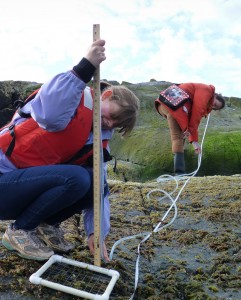
Catriona and Claudia demonstrate skill and teamwork using the water-level to measure vertical height to the next sample.
Courtney is a big fan of elephant seals and so she was keen to help with the first elephant seal measurements this morning and assisted in working out a way for one person to measure the elephant seals without disturbing them. As of this afternoon the marine railway is the new ruler and first measurements made of a young male were very close to those made earlier with a laser, measuring device. The laser technique required two people, two long boards, a right angle check and eye safety protocols. The laser technique had potential to bother the animal (if it was awake). The new technique is passive, non-invasive and non-threatening.
I saw a juvenile Bald Eagle attack a goose sitting on her nest today. I had suspected this was going on but good to verify. The eagle might have been successful with back-up, but the gander flew in and together with the goose, drove the eagle off. You can guess who I was cheering for. I know it is not science but there is no hockey out here and I am Canadian, eh.
Gorgeous Day.
What a gorgeous day. It started and ended on equally lovely notes and was nice in between. It was clear all day and light breezes from the east, eventually swung around to the west. The barometer was fairly steady, not doing much and the forecast is for those westerlies to come up tonight and tomorrow.
It is incredibly beautiful here right now with the flowers blooming everywhere, a legacy from light-keepers with gardens. Tulips, daffs, bluebells, grape hyacinth, snapdragon, phlox and calendula are everywhere, reminders the long history of the place going back to when light-keeping happened here at Race Rocks, before Canada was a country. The stone cairns bear witness to people using this place long before it was a light station and a worry today is that the Canada Geese are over-grazing and trampling these iconic and ancient cairns.
I was off-station today, my first trip since arriving twelve days ago. Everything worked well including the winch, marine railway, carriage and the Boston Whaler with its Yahama engine. Alex (my husband) came back with me and will spend a few days here.
Emil, one of the Pearson College students here over the weekend sent me this photo to include in the blog. You can see that they were enjoying being theatrical and generally had a great time on the rock.



